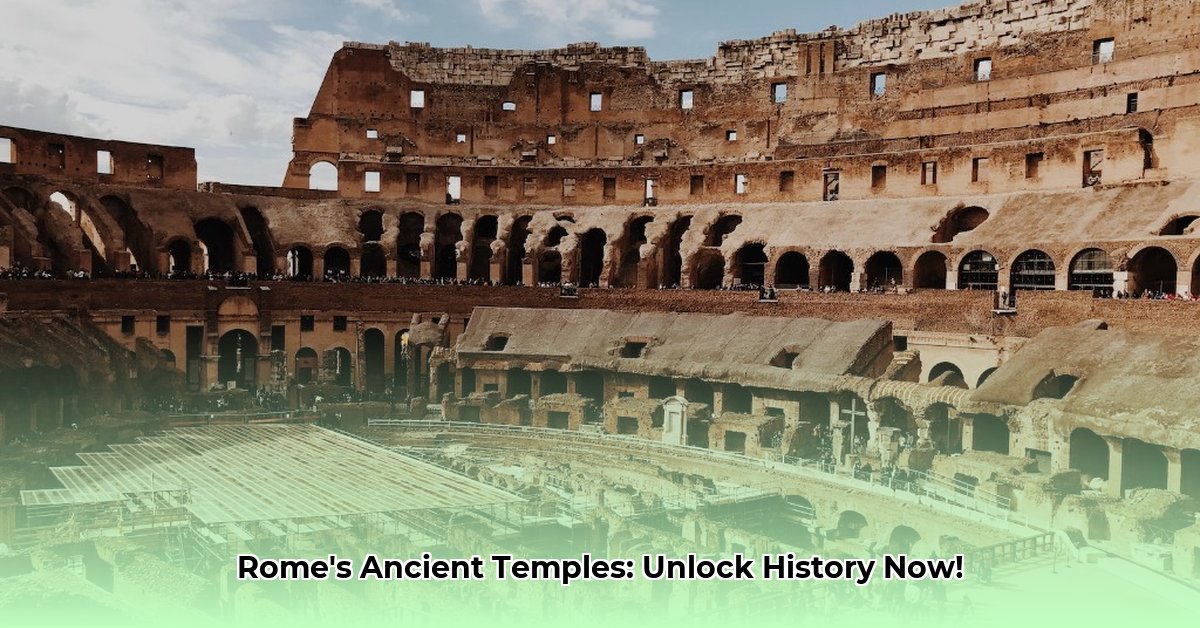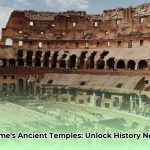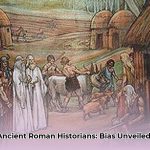## Ancient Roman Temples: Unveiling Architectural Masterpieces, Sacred Spaces, and Enduring Legacies
**Key Takeaways:**
* Roman temples served as multifaceted hubs for religious observance, civic engagement, and the embodiment of cultural identity, extending far beyond mere places of worship.
* Temple construction intricately evolved, blending Etruscan and Greek architectural principles into a distinct, monumental Roman style, characterized by groundbreaking engineering and aesthetic innovation.
* These sacred structures honored a vast and diverse Roman pantheon, with each temple dedicated to specific deities, reflecting the broad spectrum and complex nature of Roman religious beliefs and practices.
* The strategic conversion of many pagan temples into Christian churches ensured their remarkable preservation, marking a significant transitional chapter in religious and architectural history.
* The profound legacy of Roman temple architecture endures, with its classical elements, structural principles, and design philosophies continuing to inspire and influence modern building design globally.
### Decoding Roman Temple Architecture, from Foundations to Friezes
What truly defines a Roman temple? It is a masterful fusion of engineering prowess and profound artistry. The architectural journey of Roman temples began with strong influences from Etruscan and Greek traditions, but it ultimately forged a unique and definitive Roman style. Early temples during the Republican era, such as the initial Temple of Jupiter Optimus Maximus on the Capitoline Hill, often prioritized robust construction and functional aesthetics. However, as the Roman Empire expanded, so did the ambition and sophistication of temple design, embracing increasingly opulent forms and revolutionary construction techniques, perhaps best exemplified by the concrete dome of the Pantheon.
You can further explore these **[ancient Roman structures](https://www.lolaapp.com/famous-structures-in-ancient-rome/)** online. The hallmarks of this classic Roman look include instantly recognizable columns, primarily in Doric, Ionic, and the highly ornate Corinthian orders. The Temple of Antoninus and Faustina in the Roman Forum, with its towering Corinthian columns, stands as a prime illustration. Intricately sculpted pediments, frequently narrating mythological scenes or pivotal historical events, also characterized these structures. Altars, central to sacred rituals, were typically positioned at the front of the temple. Builders predominantly used highly durable materials such as solid marble, versatile concrete (a Roman invention), and sturdy brick, often faced with decorative stone, ensuring the longevity that allowed many to survive millennia. Renowned architects like Vitruvius meticulously outlined principles emphasizing harmony, precise proportion, and monumental scale, guiding the development of countless ancient Roman temples across the empire.
### A Pantheon of Purposes: Honoring the Divine
Did you know Roman temples catered to an entire pantheon of gods and goddesses, rather than solely focusing on a single deity? Temples dedicated to Jupiter, the supreme god, such as the colossal Temple of Jupiter at Baalbek in modern-day Lebanon, consistently stood as the most imposing structures, often dominating civic centers. However, sacred spaces also honored Venus, the goddess of love, evident in Rome’s Temple of Venus Genetrix, and Mars, the god of war, celebrated at the grand Temple of Mars Ultor in Augustus's Forum. Countless other figures, from minor household gods to deified emperors, each found a significant place within the sprawling Roman religious landscape.
A clear distinction existed between public temples, broadly accessible to all citizens for general worship and civic functions, and private ones, serving specific families, guilds, or cults, such as the numerous hidden Mithraea found underground throughout Rome. Consider the Pantheon, a marvel dedicated to "all gods" and renowned for its massive, unreinforced concrete dome—a testament to Roman engineering and spiritual ambition. Equally vital was the circular Temple of Vesta in the Roman Forum, which famously housed the sacred flame symbolizing the heart of Rome's eternity. Each played an indispensable role in Roman religious life, acting as critical centers of devotion and collective identity.
### Temples as Dynamic Civic Hubs Across the Empire
Beyond their primary religious functions, Roman temples transcended into vibrant community hubs, bustling with diverse civic activities. Imagine the vibrant activity: social gatherings, crucial public ceremonies, and even political rallies, all unfolding in and around these sacred spaces. The Forum of Caesar, dominated by the Temple of Venus Genetrix, exemplifies this integration of sacred and civic functions. Leaders frequently commissioned temples not only to demonstrate their piety and garner divine favor but also to enhance their imperial power, often commemorating military victories or personal achievements, as seen with the Temple of Vespasian and Titus in the Roman Forum.
Religious festivals, elaborate purification rituals, grand processions, and solemn animal sacrifices profoundly reinforced social bonds and underscored the pervasive influence of the divine in everyday Roman life. The Temple of Saturn, one of the oldest in the Roman Forum, not only housed the state treasury but also served as the focal point for the raucous Saturnalia festival. So, when you envision a Roman temple, whether it's the Temple of Portunus with its well-preserved façade or the scattered ruins of the Temple of Castor and Pollux in the Roman Forum, don't merely picture an ancient building. Instead, envision it as a dynamic, bustling nucleus of Roman society and culture, a place where the spiritual, political, and social converged.
### Connecting with the Divine: Ritual and Reverence
The deliberate design and precise layout of Roman temples were meticulously crafted to create a sacred environment, inviting worshippers to partake in rituals and prayers that facilitated a profound connection with the gods. Highly respected priests and priestesses, often drawn from elite Roman families, meticulously managed these temples, leading complex ceremonies and rigorously maintaining their sanctity. From the Roman perspective, temples were not just buildings; they were considered the literal dwelling places of the gods themselves, tangible links between the mortal and the divine. This deep reverence shaped every aspect of their construction, decoration, and daily use, from the placement of cult statues to the orientation of the building.
### From Temples to Churches: A Legacy of Adaptation
With the advent and eventual triumph of Christianity across the Roman Empire, what became of these magnificent pagan temples? Many underwent a remarkable and strategic transformation, a testament to both practicality and spiritual assimilation. They were skillfully converted into Christian churches, adapting their existing structures to accommodate new religious practices. Altars were repurposed, Christian symbols were subtly integrated, and spiritual life continued, albeit with a different theological focus.
This adaptive reuse was crucial for their preservation. The Pantheon, originally a temple to all gods, was famously converted into the Church of Santa Maria ad Martyres in 609 AD, preserving its colossal dome and structure. Similarly, the Temple of Portunus, a rare survivor in the Forum Boarium, became the church of Santa Maria Egiziaca, and the Temple of Hercules Victor, the oldest marble temple in Rome, became Santa Maria del Sole. Outside Rome, the exquisitely preserved Maison Carrée in Nîmes, France, owes its survival to its early conversion into a church. While some temples regrettably fell into disrepair or were dismantled for building materials over time, others were meticulously preserved and lovingly integrated into the expanding Christian tradition, representing a fascinating and pivotal chapter in the enduring story of Roman religious architecture.
### The Enduring Echoes of Roman Design: A Global Influence
Even today, if you observe closely, you can discern the unmistakable echoes of Roman temple design in contemporary architecture across the globe. Those commanding columns, the dignified pediments, and the soaring domes are not merely relics of the past; they are timeless classical elements that continue to inspire modern architects and designers worldwide. From government buildings and cultural institutions to grand private residences, the architectural heritage of Roman temples remains a powerful, pervasive influence on design principles, demonstrating the enduring appeal of their harmony, proportion, and monumental grandeur. Their ingenuity in materials like concrete revolutionized construction, and their emphasis on grand public spaces continues to shape urban planning. [Learn more about Roman Temples.](https://romanhistory.org/structures/roman-temples)
### Actionable Intelligence: Leveraging Roman Temple Insights
Here's how different people can leverage this comprehensive information for diverse applications:
| Stakeholders | Actionable Steps |
| :---------------------------- | :------------------------------------------------------------------------------------------------------------------------------------------------------------------------------------------------------------------------------------------------------------ |
| **Historians/Archaeologists** | Utilize this contextual information to guide precise excavations, interpret artifacts, and map the evolution of Roman religious and civic life through architectural remains at temple sites. |
| **Museums/Cultural Institutions** | Develop captivating exhibits and virtual tours that showcase the intricate temple architecture, its profound religious significance, and its role as a civic center within Roman society, drawing on specific examples. |
| **Educational Institutions** | Integrate the detailed study of Roman temples into history, art, and classical curricula, providing students with rich, tangible insights into ancient Roman culture, engineering achievements, and religious practices. |
| **Tourism Industry** | Strategically promote well-preserved temple sites, both in Rome and elsewhere (e.g., Baalbek, Maison Carrée), enhancing tourist itineraries by highlighting their historical importance, architectural beauty, and practical visitability. |
| **Architects/Designers** | Draw inspiration from classic Roman temple designs and construction methods for contemporary architectural projects, integrating their timeless aesthetic, structural principles, and innovative use of materials like concrete. |
| **Religious Scholars** | Analyze the profound shift in purpose and adaptation of temples from their original Roman pagan contexts to their later roles as Christian places of worship, exploring the dynamics of religious syncretism and conversion. |
| **Urban Planners/Developers** | Study the Roman integration of public buildings like temples into civic spaces to inform modern urban design, focusing on creating functional and aesthetically pleasing public realms that foster community engagement. |










